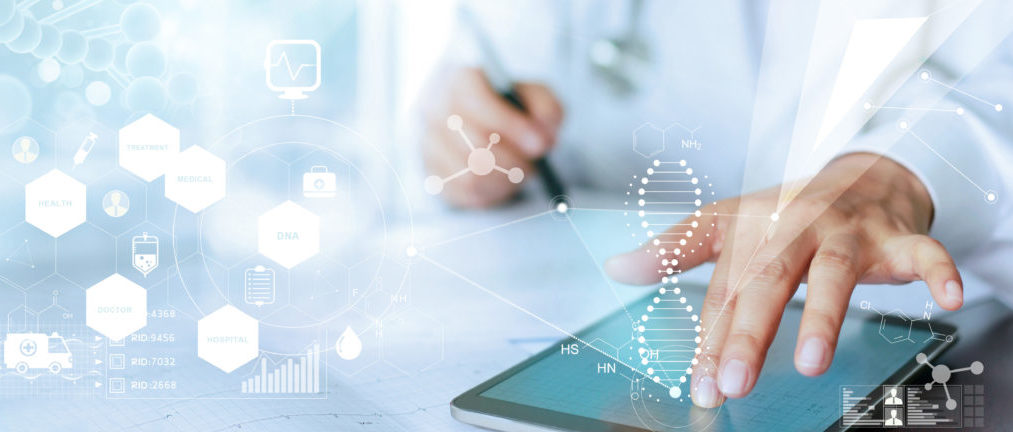What an exciting, promising whirlwind #HIMSS19 has been. This conference that distills all of the industry’s innovation and complexity is a crystal ball; when you look around the room, you are seeing, hearing, and experiencing the future of healthcare.
Out of everything that I took in, one observation stood out in particular. Seema Verma, administrator of the Centers for Medicare and Medicaid Services (CMS), spoke this year as well as last. In 2018, she remarked that using fax machines for healthcare transactions should be phased out. This year, she called for a wholesale push for interoperability that would give payers and providers instant, accurate, and complete access to patients’ electronic health records. This patient-centered initiative is often referred to as the “Blue Button” app, and there are 1,500 developers currently working on it. This digital revolution would create health records at birth that include every appointment, test, diagnosis, and data from the Internet of Healthcare Things devices into a record, which could be blockchain-enabled to ensure accuracy and security.
If you ask me, that’s like graduating from a foot-powered Flintstone’s car to a Lamborghini over the course of one year. How did we make such a leap from literally cutting the cable on fax machines to a wholesale, easy-to-use, innovative concept?
The question is, what is leading that swift progress? The answer: healthcare consumerism.
We’ve explored healthcare consumerism before, but what it boils down to is listening to patient-consumers and following their lead, needs, and desires rather than purely offering instruction. This concept has existed for a while but has skyrocketed recently because of millennials. The first generation of “digital natives” is making more and more healthcare decisions, and doing so with $3.4 trillion in buying power. In fact, as soon as next year, they’re slated to make the majority of healthcare decisions.
Just look at the language Verma used: “The idea the patient data belongs to providers or payers is an epic misunderstanding. Patient data belongs to patients. … Information blocking is a thing of the past.” She elaborated that the app would be transferable from doctor to doctor and plan to plan, almost like transferring your contacts when you upgrade your iPhone.
What does this mean for the industry? National Coordinator for Health Information Technology Don Rucker, MD, said to Modern Healthcare: “I think this will — combined with the modern app economy and the tools that are available, the bandwidth that’s available — materially change the way care is delivered and the way patients are empowered. … This is a way to get patients back into the game.”
That’s the goal. Everything we do — from doctors to developers — comes back to benefitting patients. Interoperability, which dominated the discussions at HIMSS, is one route to achieving that ambitious, yet necessary, goal.

Our doctors are based in your community, centered on your needs, and part of a national network that’s transforming healthcare.

Healthcare, handled.
You have enough on your plate. We make it easy to message your doctor, connect to on-demand virtual care, receive appointment reminders, refill prescriptions, and more.

Healthcare for the long haul.
You’re more than a set of symptoms. From pediatrics to adult needs, preventive programs to complex care – we’re here to support you on every step in your journey.

Our doctors do more.
You can enjoy personalized care without pricey fees. Our doctors take time to listen to your concerns, from wellness programs to chronic care management.


Healthcare, handled.
You have enough on your plate. We make it easy to message your doctor, connect to on-demand virtual care, receive appointment reminders, refill prescriptions, and more.

Healthcare for the long haul.
You’re more than a set of symptoms. From pediatrics to adult needs, preventive programs to complex care – we’re here to support you on every step in your journey.

Our doctors do more.
You can enjoy personalized care without pricey fees. Our doctors take time to listen to your concerns, from wellness programs to chronic care management.
Newsroom
inforMD Blog
Events
Presentations
The Break Room
Search Results
Information Center | Newsroom | Multimedia | Blog | Podcast
-
- Who We Support
- What We Offer
- About Us
- Careers
- Media
Looking for Coronavirus (COVID-19) information? View resources for patients.
Stay inforMD! Sign up to receive the latest healthcare news and trends.
This website uses cookies so that we can provide you with the best user experience possible. Cookie information is stored in your browser and performs functions such as recognising you when you return to our website and helping our team to understand which sections of the website you find most interesting and useful.
Strictly Necessary Cookie should be enabled at all times so that we can save your preferences for cookie settings.
If you disable this cookie, we will not be able to save your preferences. This means that every time you visit this website you will need to enable or disable cookies again.
Are you interested in finding out more about PRIVIA+?


Related Articles
How to Keep Your Patients From Skipping Mammograms
Kristin Schraa, MD, with Virginia Women’s Center shares how women’s health providers can encourage patients ...
3 Ways Healthcare Can Integrate Behavioral Health and Primary Care
Integrating behavioral health with primary care can lead to better patient outcomes — but how ...
How Can Physicians Support Postpartum Mental Health?
On average, 13 percent of mothers in the United States will develop symptoms of postpartum ...
Engaging Patients in Annual Mammograms
Studies show that a little over 66 percent of women aged 40 and older get ...
What Do Medicare-Aged Patients Want in Their Healthcare?
Within the next 20 years, 20 percent of Americans will be 65 or older. It ...
How Health Systems Grow Stronger With Privia Health
Discover how we helped Health First upgrade technology, align physicians, and accelerate toward value-based care. ...